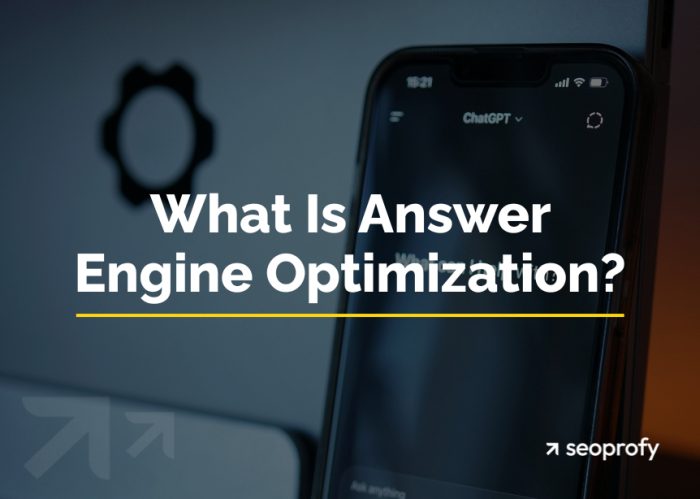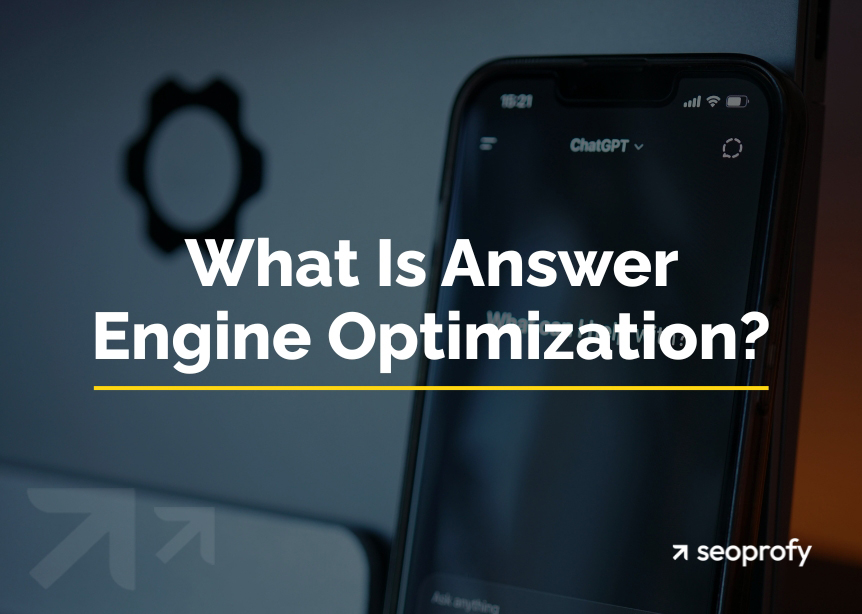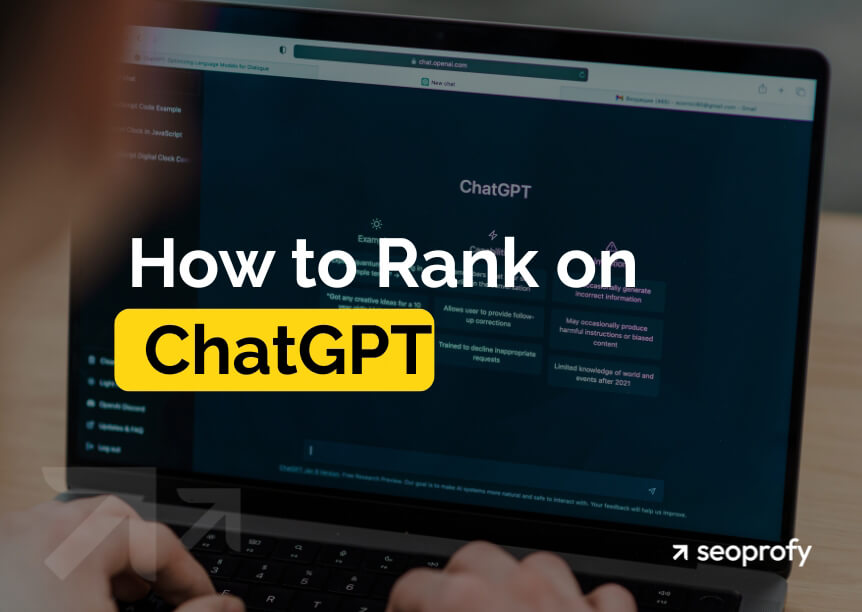Answer Engine Optimization (AEO) is a digital marketing strategy that ensures your content is machine-readable and ready to be served as a direct response in AI-driven search. It involves structuring pages, headings, and data so AI engines can easily extract key facts and present them in formats like featured snippets, voice responses, and Google AI Overviews. The aim is to control how your brand appears when users want quick answers, increasing trust, visibility, and qualified traffic from modern search channels.
At SeoProfy, we have seen how quickly interest in Answer Engine Optimization has grown as brands fight to be the answer AI engines choose. This article shows the exact methods we use to make content appear in Google AI Overviews, ChatGPT, and voice results. Keep reading if you want practical steps you can apply right away to raise your brand’s visibility.
- AEO strategy makes your content machine-readable so AI engines can select it as the direct answer in Google AI Overviews, ChatGPT, and voice results.
- Practical strategies cover researching user intent, structuring concise answers, using schema, building topical authority, and tracking performance.
- AI answer positions are volatile and require ongoing tracking with GSC, Semrush, and AI citation tools, plus regular iteration.
What Is Answer Engine Optimization (AEO)?
Answer Engine Optimization is the process of getting your brand into Google AI Overviews, ChatGPT responses, and other AI engine answers where users look first. It may sound like just another buzzword in the growing pile of AI-related newspeak, but AEO is a practical framework with real impact on visibility and traffic.
Not rarely during client consultations we see that the difference between traditional SEO, Google’s new GEO, and AEO strategy is not always clear. That is why we first explain each term so there is no confusion, and then we share a comparison table where we mapped the main criteria so you can see the difference at a glance.

SEO (Search Engine Optimization) is the classic approach that has been around since the early 2000s. The main idea is to get your page to rank high in traditional search engines. Google sees relevance, ranks the page, and sends you clicks. You work with keywords, links, and technical setup to make your page better optimized and positioned above competitors.
GEO (Generative Engine Optimization) is the method of teaching AI models to think of your site as an authoritative source. It is not so important that they take your text word for word. What matters is that your data, articles, and research are included in their index and become part of their knowledge. The goal is to have the model mention you or your brand in its generated response, often without a direct link.
AEO (Answer Engine Optimization) is about exact answers. You prepare content so that AI or search engines can extract a ready-made piece of text and display it as a direct answer, such as a quote, a block in Google AI Overview, etc. As a result, it is no longer just the model retelling what you once published but your actual wording or structured data being used as the answer.
| Criteria | Traditional SEO | Generative Experience Optimization | Answer Engine Optimization |
| Main Goal | Rank web pages higher in SERPs to capture organic clicks | Influence generative AI summaries and AI Overviews with helpful content | Get content selected as the direct answer for specific questions |
| Focus | Keywords, backlinks, technical health | Content depth, topical authority, EEAT signals | Precision, clarity, structured data, and direct answers |
| Primary Output | Blue link listings | AI-generated responses, summary blocks, multi-source overviews | Featured snippets, AI Overviews, voice responses |
| Content Style | Comprehensive, long-form, often broad in scope | Context-rich, covering multiple subtopics to feed LLMs | Concise, structured, answering a single question clearly |
| Technical Elements | Meta tags, crawlability, speed | Schema markup for entities, FAQ, how-to, review data | Advanced schema, Q&A format, structured lists, machine-readable facts |
| Measurement | Rankings, traffic, CTR | Inclusion rate in AI summaries, exposure share | Appearance rate as AI-selected answer, visibility in AI engines |
| Time to Results | Gradual, compounding over months | Variable, depends on indexation and trust signals | Faster if content is precise and well structured |
| Competitive Edge | Link building, domain authority | Topic coverage, depth, and semantic relationships | Content clarity, authority, and optimization for direct retrieval |
How AEO Works?
Before we jump into the best tips for Answer Engine Optimization in AI, let’s first look at how AI engines process and deliver answers. Understanding this flow will make the recommendations later in the article feel like a natural next step rather than a random checklist.
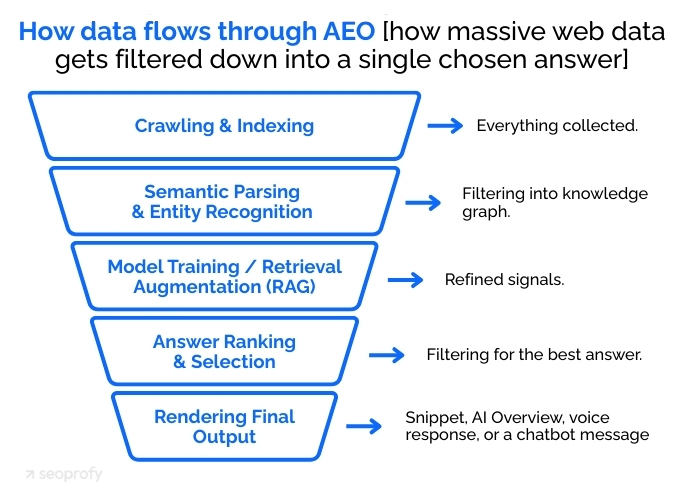
1. Crawling and Indexing
AI engines still start with a web crawl similar to Googlebot. They fetch pages, parse HTML, and store text, metadata, schema markup, and structured data into an index. This is why technical SEO basics still matter because a page that blocks crawlers or has broken structure is invisible to the system no matter how good the content is.
2. Semantic Parsing and Entity Recognition
Once content is indexed, AI systems break it down into entities and relationships. They map facts, numbers, names, and topics to a knowledge graph. This step determines whether the engine considers your brand credible for a given topic.
3. Model Training or Retrieval Augmentation
From here, the data either becomes part of the model’s training set or gets used dynamically with retrieval augmented generation (RAG). The model needs clear signals to know what your answer is.
4. Answer Ranking and Selection
When someone asks a question, the engine pulls candidate passages and scores them for relevance, authority, and clarity. It then picks the one that gives the most confident answer. Our experience and Semrush studies show a strong overlap between these chosen passages and Google’s top 10 organic results which means SEO authority opens the door but AEO is what gets you chosen.

We also frequently see AI engines select passages from page two, three, or even deeper in the search results when that content gives a clearer or more precise answer. This means that even if you are not ranking on page one, it is still possible to have your answer surfaced and outrank top competitors inside AI Overviews and other AI-powered results.
5. Rendering the Final Output
Finally, the engine packages the chosen answer into whatever format the interface needs, such as an AI Overview card, a snippet, a voice response, or a chatbot message. The cleaner and more direct your data is, the more likely it will appear with a link to your site, which sends qualified traffic right back to your website—one of the main benefits of AEO.
Why Does the Future of Your Brand Depend on AEO Implementation
AI optimization is critical because search is no longer about ten blue links and waiting for a click. Here is what is happening right now:
- Users shift to LLMs: People ask Perplexity, Google AI Overviews, and ChatGPT for answers and expect them instantly. For example, nearly 800 million people around the world use ChatGPT every week, which shows how fast generative AI is becoming the default way users search. If your brand is not part of these answers, you are effectively invisible.
- AI-driven search will be accelerating: 18.7% of SEO specialists expect significant industry changes due to AI and machine learning, and user behavior proves them right. In 2024 around 15 million adults in the US reported using generative AI as their primary search tool, and by 2028 this number is projected to exceed 36 million.
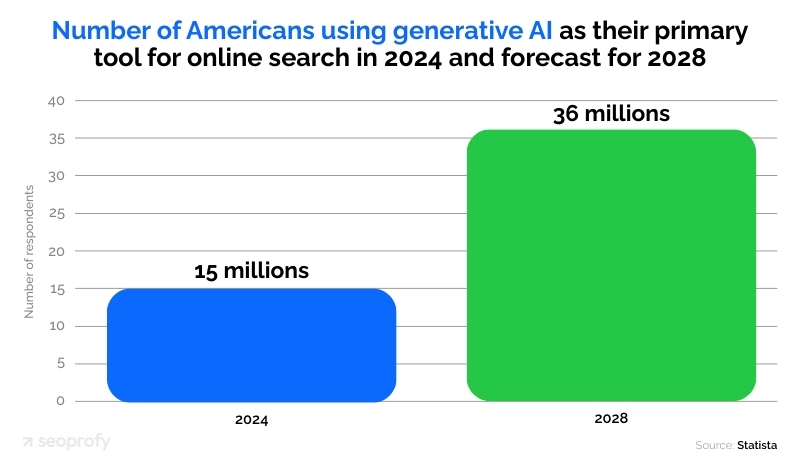
- Zero-click searches dominate: Over half of user queries (58.5% in the U.S. and 59.7% in the EU) end without a click as answers appear directly in search. Implementing AEO strategy helps you own those answer boxes.
- Voice search is exploding: Over 25% of people use voice search several times a day, and there are more than 88.8 million voice assistant users in the US. Voice assistants usually read only one answer aloud, which makes being that chosen answer so important.
- Personalized results impact buying decisions: 76% of consumers say they are more likely to buy when the experience feels highly customized, which means appearing in AI results that match the user’s context directly influences conversions and revenue.
If your content is not optimized for AI you risk losing visibility exactly where users are making decisions. The next section explains how to make sure AI engines pick your answer first. Every strategy we cover has been tested on live client websites and selected because it delivers exceptional gains in visibility, traffic recovery, and lead generation.
Make your brand discoverable in answer engines. AEO strategies unlock traffic from zero-click searches and build trust where buyers make decisions.
- Show up in AI Overviews & SGE
- Attract high-intent traffic
- Build authority
- Generate leads from answer boxes

Key Strategies for Implementing AEO
From here we move into the steps that decide whether your brand shows up in AI answers or stays hidden. Apply them, and you can outpace competitors even if they still outrank you in classic search.
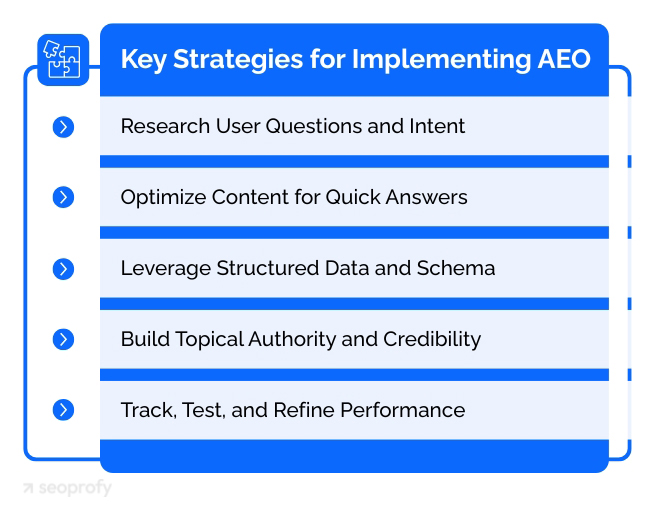
Research User Questions and Intent
If you want your content to be the one AI engines choose, you have to start by understanding what people actually ask and why they ask it. The better you capture real user intent, the easier it is to create answers that AI engines trust and show first.
1. Explore “People Also Ask” in Depth
The simplest and most overlooked research tool for Answer Engine Optimization is right in the search results. Type your target query and open the “People Also Ask” box. This gives you an instant list of common pain points and subtopics.

2. Mine Search Console for Hidden Gold
When you perform Answer Engine Optimization (AEO) for AI, go to Search results → Queries in the Google Search Console dashboard and filter for words like “how,” “what,” “why,” “when,” “can,” “should,” “is,” and “are.” Look for terms with high impressions but low CTR because these are cases where Google thinks your page is relevant, but users are not finding the answer compelling enough to click. Add or rewrite a section to give a clear and direct answer.
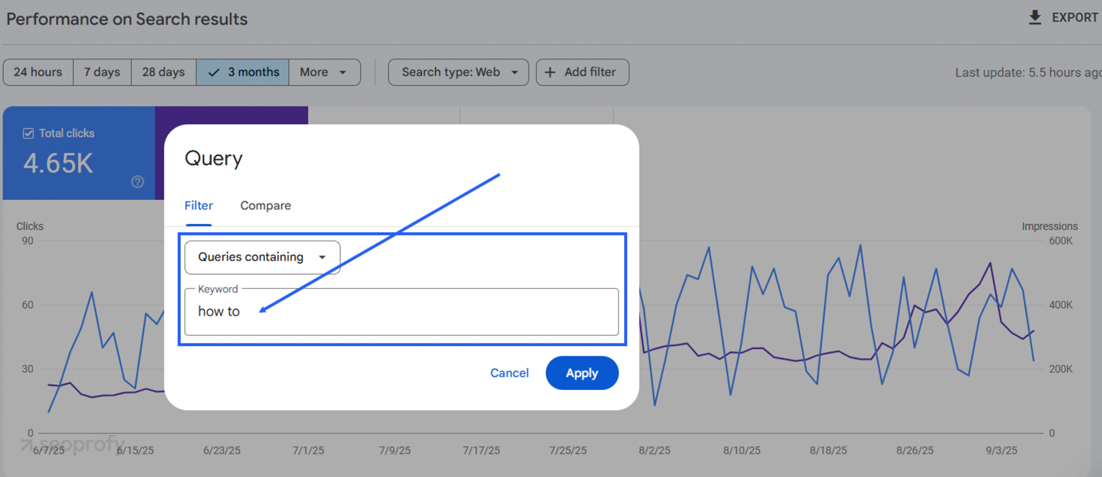
3. Use Ahrefs and Keyword Tools for Depth
In Ahrefs, open Site Explorer → Organic Keywords, apply an Include filter for question words, and sort by Traffic Potential. Export the data and group questions by intent, such as informational, transactional, or navigational.
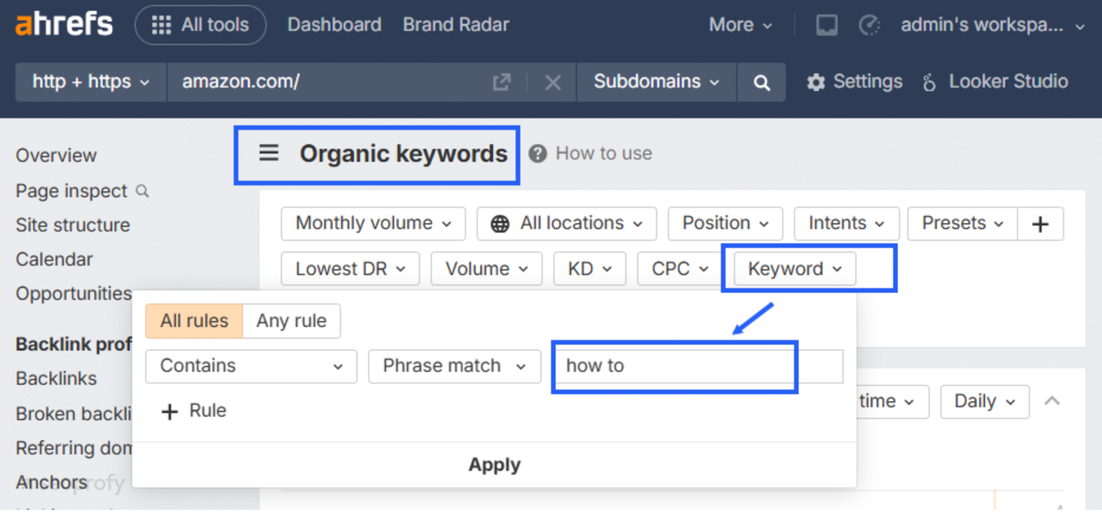
In Semrush, use the Keyword Magic Tool, switch to Questions, and apply an Intent filter to focus on informational queries. Export and organize the results into clusters that can be addressed on a single page or within a hub.
4. AlsoAsked and AnswerThePublic
These tools show the follow-up questions users ask after their initial search. Enter a seed query and download the results. The visual question trees are useful for planning subheadings and FAQ sections.
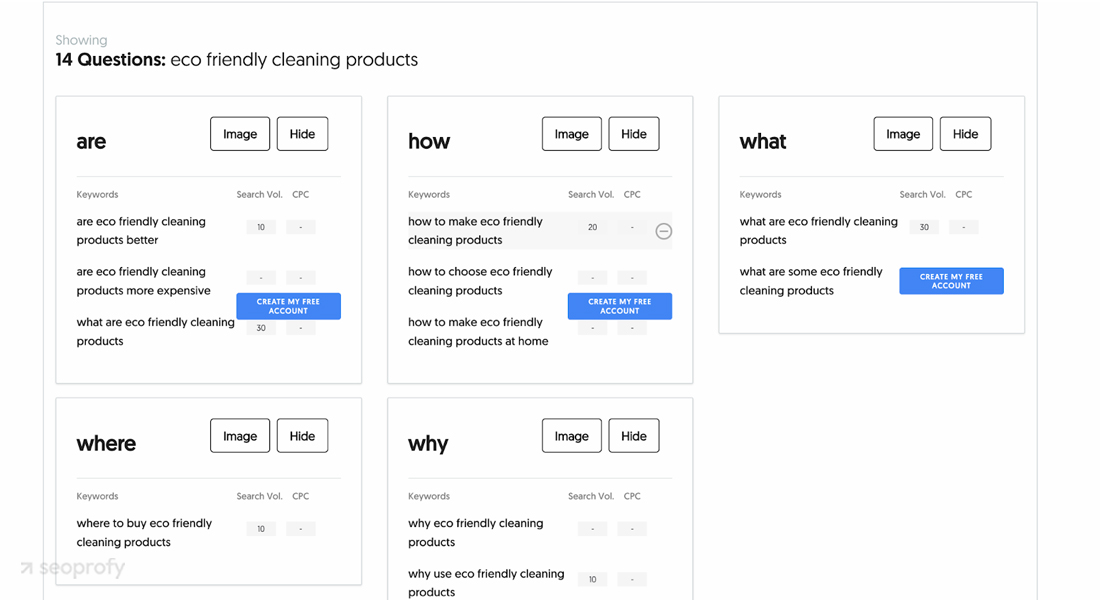

5. Map Questions to Intent
Once you have a complete list, group questions by task intent, such as “define,” “compare,” “fix,” and “buy,” and by the core entity, such as product, feature, or use case. Matching the right content type to the intent improves relevance and raises the chance that AI engines pick your page as the answer.
Building a question intent matrix helps plan content that covers every stage of the search journey. It can also highlight quick wins.
Optimize Content for Quick Answers
AI engines process text as tokens, not words, usually reading in chunks of around 300 to 500 tokens at a time. ChatGPT and Gemini can handle thousands of tokens in one go, but they still look for dense, clearly structured information first. Proper structuring makes your page easier to “digest.” So, it increases the chance that your answer gets selected.

Steps to structure content for AI-friendly answers:
- Start with a clear question heading: Use H2 or H3 in question form, such as “What is SEO?” This is one of the best LLM optimization techniques for AI visibility, as it helps AI engines match queries to sections quickly.
- Answer first in 40–60 words: Write a direct, self-contained answer in the first paragraph under the heading. Use a conversational tone: voice assistants (Google Assistant, Siri, and Alexa) favor short, natural answers that sound like something a person would say.
- Expand with context and depth: Follow the short answer with supporting detail, examples, and internal links to strengthen authority and satisfy users who want more.
- Cover local intent: Include city names, neighborhood references, and phrases like “near me” in headings and body text where relevant. This is essential for local businesses and services.
- Use lists and tables when possible: Step-by-step lists, pros and cons, and comparison tables are easy for AI to parse and often preferred for “how to” and “vs” queries.
- Check competitors in AI Overviews: Look at pages already selected for AI answers. Note their length, format, and use of lists or tables, then make your version clearer and more complete. Some niches favor short paragraphs; other queries call for lists or comparison tables.
A simple 15-minute manual review of AI Overviews for a few “how to” queries across different niches showed clear patterns. In the legal niche, especially on topics like forming an LLC, list-style sections are more common and often presented as step-by-step guides.
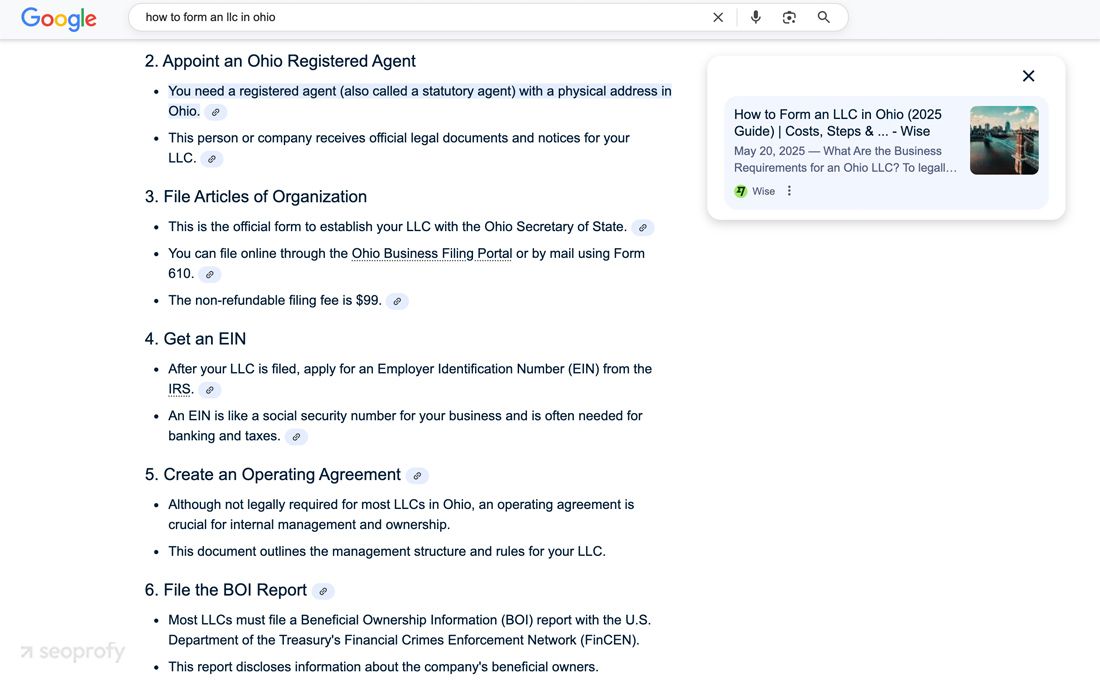
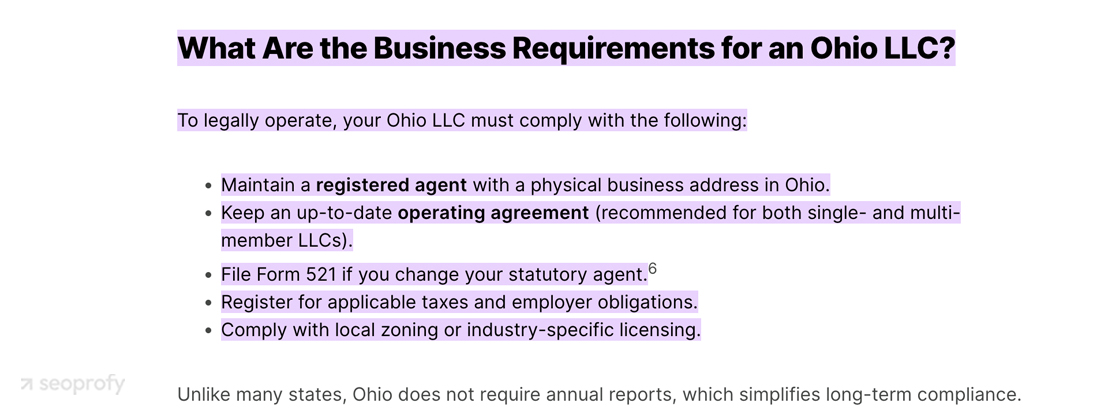
When you look at results for “how to choose a gaming laptop,” Google favors a different structure, where the selected sources lead with a short and direct answer before providing any extra detail.
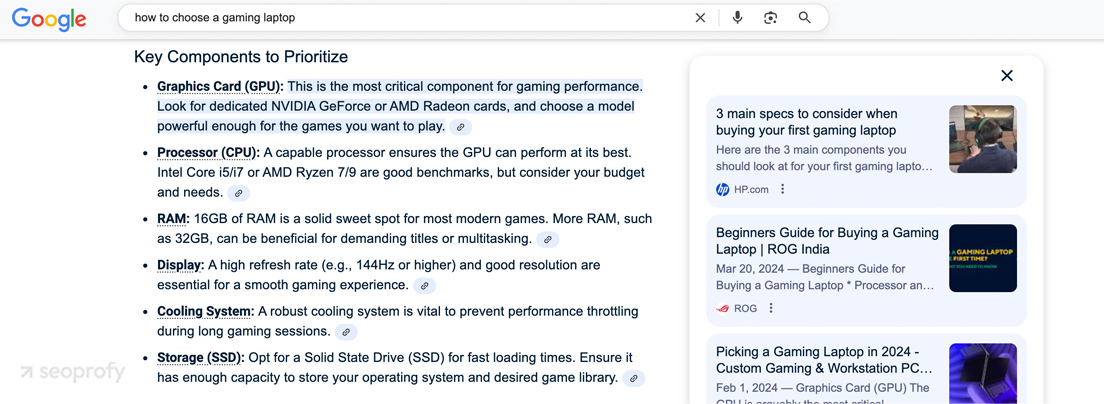
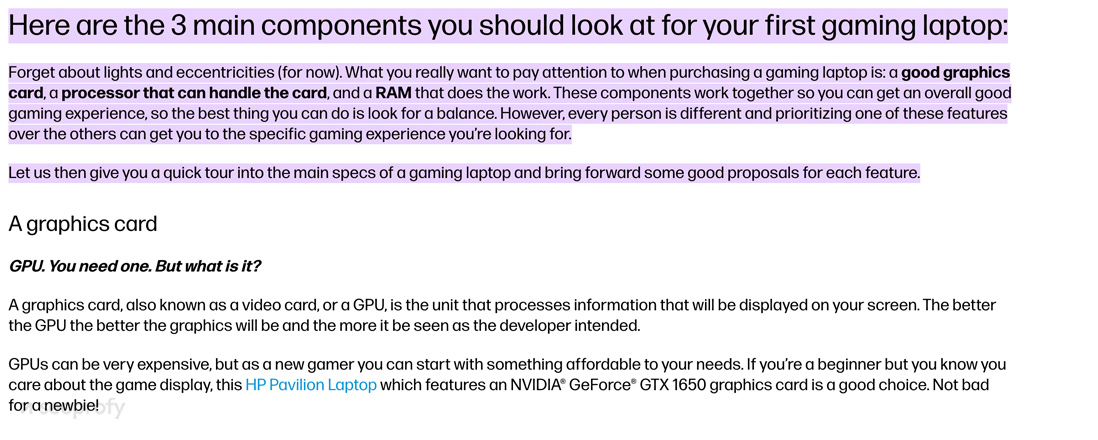
If your goal is to rank on ChatGPT, running a quick manual check also shows consistent patterns. It only takes a few minutes but still gives a clear picture.
Leverage Structured Data and Schema
AI engines do not just read your content; they parse it. Schema tells them exactly what each piece of text means and turns your page from another paragraph on the web into a trusted data source. Well-implemented structured data is one of the fastest ways to win rich results and even voice answers.
Most impactful schema types for AI optimization:
- FAQ Page: Mark up real user questions and answers. This is often the easiest way to get picked for conversational queries and to appear in People Also Ask boxes.
- HowTo: Perfect for tutorials and step-based content. Mark each step, required tool, and image so AI can reproduce the process in order.
- Speakable: Highlights the sections that should be read aloud by voice assistants. Great for news, local businesses, and quick facts.
- Article/Blog Posting: Adds metadata like headline, author, and mainEntityOfPage, which strengthens authority signals and improves trust, vital for answer engine optimization.
Here is a minimal JSON LD example for a delivery question:
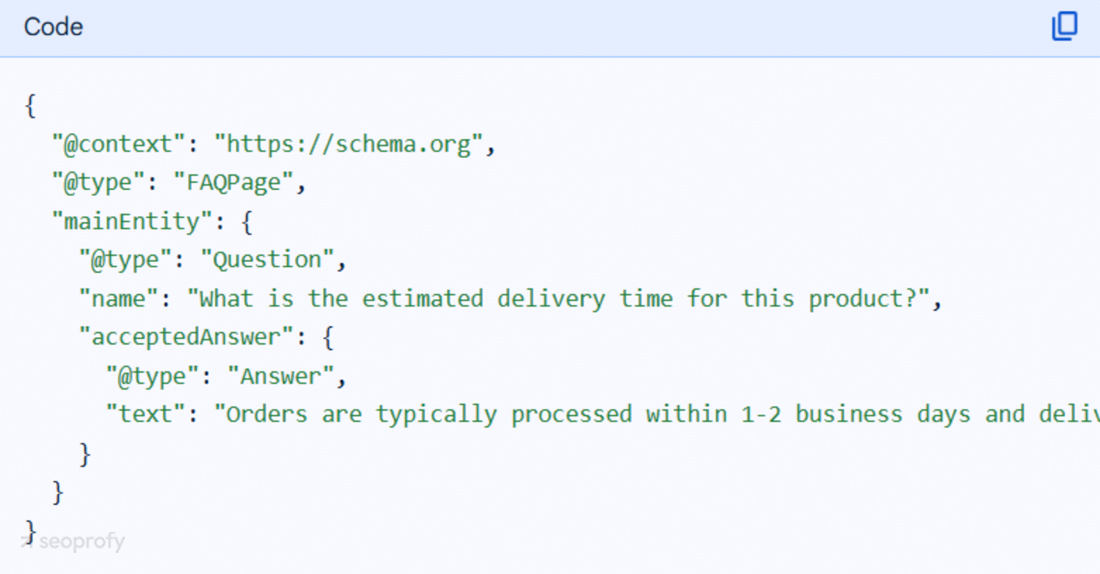
Test your schema with Google Rich Results. Test and monitor coverage in GSC. Clean, error-free markup makes it easier for AI engines to select your page confidently and show it with attribution, which is the main goal of Answer Engine Optimization.
Build Topical Authority and Credibility
Search engines and AI models look for clear signs of authority before they decide whose answer to show. If a site only mentions a topic once in a short post, it rarely looks like the authority.
When you build a cluster of related pages, show real experts behind the content, and get mentioned on other trusted sites, you create a strong signal that says “this brand knows what it is talking about.” That makes AI Overviews and chat models pick you over competitors. Let’s take a detailed look at the steps that matter most:
- Content clusters: Build a hub-and-spoke structure with in-depth pages on every subtopic. Interlink them logically to create a clear topical map.
- Expertise & authors: Show expert bios with credentials, link to LinkedIn profiles, and display publication dates.
- Trustworthy citations: Reference primary research, government data, or peer-reviewed studies where possible.
- Off-site mentions: Earn backlinks from reputable sites, citations in articles, podcast appearances, and business listings.
- Reputation signals: Monitor and improve online reviews, star ratings, and mentions on third-party sites.
Track, Test, and Refine Performance
Unfortunately, winning an AI Overview or voice result is not the finish line. Positions in classic Google rankings tend to stay stable for weeks or months, but AI answer selections can shift several times a day (especially inside AI Overviews). Competitors are actively fighting for the same spot and will try to replace your content with theirs. Keeping visibility means constantly re-optimizing, refreshing content, and looking for ways to expand coverage.
The solution is to track AEO performance closely and treat it as a living system. Here’s how:
| Tool | What to Measure |
| Google Search Console | Impressions vs clicks for informational search queries (especially those with featured snippet exposure). |
| Semrush / Ahrefs | SERP Features column for featured snippets, People Also Ask wins, and keyword position history. Use position tracking to alert you when you lose a snippet. |
| AEO-specific tools (e.g. AlsoAsked + emerging trackers) | AI Overview citations, ChatGPT mentions, and Perplexity citations. |
| Log Files & Analytics | Changes in crawl patterns and traffic from referrers labeled as AI assistants or chatbots. |
Here’s a practical workflow you may want to follow:
- Baseline audit: Export your current impressions, clicks, and snippet ownership from GSC and Semrush. Save this as your baseline.
- Track AI mentions: Use tools mentioned above to monitor how many pages are cited in AI Overview, ChatGPT, Perplexity, and Gemini.

- Segment queries by intent: Separate branded, informational, and transactional queries so you know which clusters drive real leads.
- Run A/B content updates: Change headings, tighten answer paragraphs to 40–60 words, and add missing schema. Re-check rankings and snippet ownership after 2–3 weeks.
- Iterate: If CTR does not move or snippets are lost, rewrite for clarity, add supporting visuals or data tables, and resubmit via GSC URL Inspection for faster recrawl.
What Determines the Price and Timing of AEO Implementation
The cost and timeline for AI optimization depend on how strong your current SEO foundation is and how quickly your team can execute. Sites with clean technical SEO and existing topical authority usually see faster results, while sites that need structural fixes or content expansion require more time. Team size, experience, and familiarity with structured data and content optimization also play a key role in how fast changes can be rolled out.
At SeoProfy we combine traditional SEO expertise with tested strategies for Generative Search Optimization. Our SEO performance audit for AI visibility shows where your brand already appears in AI answers and highlights missed opportunities to expand visibility. Based on this data, we create and implement a step-by-step plan designed for your pages to rank in AI Overviews, ChatGPT, and other AI-driven search results.
Want us to put this into action for your brand? Get in touch today!


